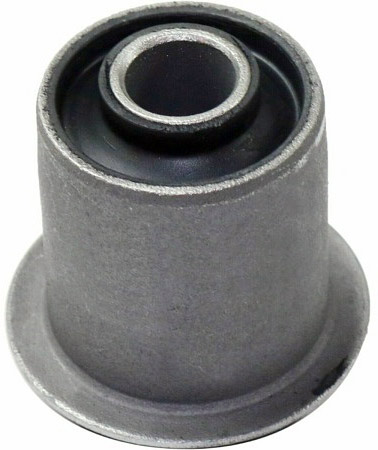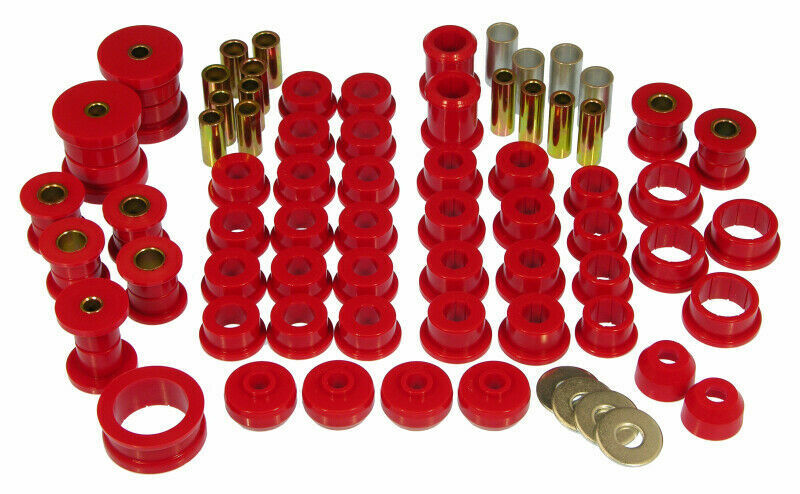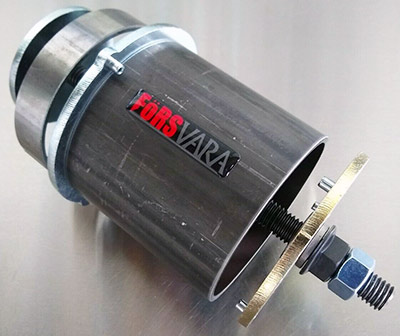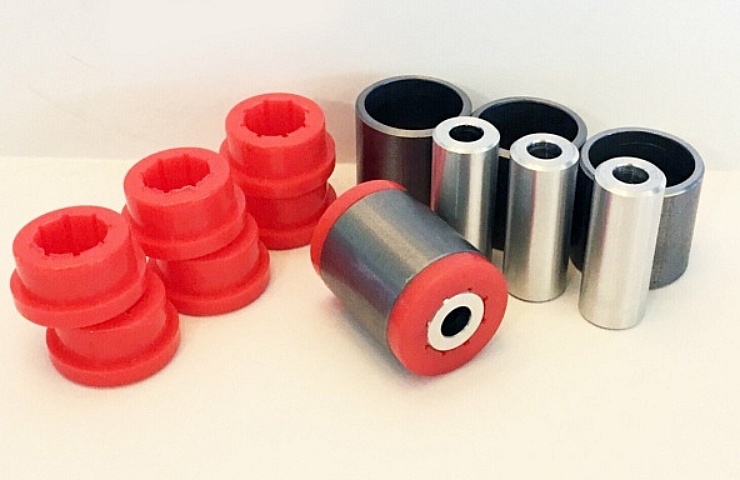Bushings are small doughnut-shaped rings of spongy material that fit between two pieces of metal. They act as absorbers, preventing the harsh friction of metal suspension parts in direct contact.

Energy Suspension sway bar bushings
Although bushings might be small, they play a surprisingly big role in your car’s handling. The cushion-like pieces help absorb road bumps, reduce vibration, and decrease noise. In addition, bushings are critical pieces of upper and lower control arms, leaf springs, sway bars, and steering racks. For older cars, bushings sit between the chassis and the body.
Shop now for suspension bushingsSometimes, it’s a matter of necessity to replace stock bushings, which are usually made of black rubber. This is because they deteriorate over time and from heat, road salt, and chemical exposure. Fortunately, bushings are typically easy to replace.
Let’s consider the options for replacing stock bushings with ones that produce a desired change in handling.
Stock Suspension Bushings Are Rubber

Stock bushings are usually black rubber.
You should periodically give your bushings a visual check for signs of deterioration. If you see cracks, indentations, or missing chunks of rubber, don’t wait to swap in new bushings.
There are also telltale signs from behind the steering wheel that a bushing needs replacement. For example, you might feel a gradual change in handling, such as much looser or stiffer steering. Or you might hear metallic clunking and rattling sounds, especially when going over bumps or cornering.
There are good reasons why stock bushings are usually made of soft rubber. First, they provide a quiet and gentle ride. Rubber bushings do not squeak and don’t need maintenance or lubrication. (That’s usually described as “self-lubricating.”)
While rubber bushings typically focus on comfort, you might be interested in a more responsive ride. In that case, you should consider switching to polyurethane.
Consider Polyurethane, Nylon, and Delrin Bushings
Polyurethane bushings are stiffer, so they flex less and give a more direct road feel. However, these bushings need periodic lubrication to avoid squeaks, binding, and excessive wear.

A complete set of Prothane polyurethane bushings for the C4 Corvette
Installing polyurethane bushings is relatively easy (compared to rubber) because they slide into place with little effort. They’re typically assembled in two pieces and can be easily installed on either side of the joint. Polyurethane bushings are commonly less expensive than rubber, and they should last the vehicle’s lifespan.
Nylon bushings are a compromise between soft rubber compounds and polyurethane. They offer some stiffness but less than what’s provided by polyurethane bushings. However, they are not as durable as polyurethane.
If you want the ultimate high-performance handling, you might consider bushings made with Delrin (or polyoxymethylene), a stiff, low-friction thermoplastic. The primary advantages of Delrin bushings are complete travel movement without binding and no squeaks. In addition, some bushings are made with Delrin AF, which includes a mixture of PTFE fluorocarbon fibers (like Teflon) that’s even more slippery.
Polyurethane and nylon components are usually the least expensive. Rubber bushings that mimic factory standards cost slightly more. High-end Delrin bushings have the highest price tags.
Installing New Suspension Bushings
To replace a specific bushing, you need proper access. That typically requires removing the part using the bushing. If you have access to a hydraulic press, that makes the removal and installation very easy. A press uses a bottle jack attached to various plates so you can press the bushing into place with 10 tons of force or more.

BMW subframe bushing removal and installation tool
You can remove the bushings with a large C-clamp as well. This often requires a piece of pipe roughly the size of the outer diameter of the bushing. In that way, you can align the clamp and push it straight through the joint.
Some vendors offer threaded rods to aid in the installation process. A threaded rod uses the force generated by the threads to pull the bushing through the joint. However, it may take more effort than a press because it requires you to crank on a pair of wrenches to push the bushing through.
It makes sense to replace all the bushings for a specific suspension piece at the same time. That provides the benefit of all the bushings acting together to give you the ride you were expecting. Those benefits range from a smoother ride protecting passengers from bumps to a more responsive experience for performance drivers taking curves at speed.





